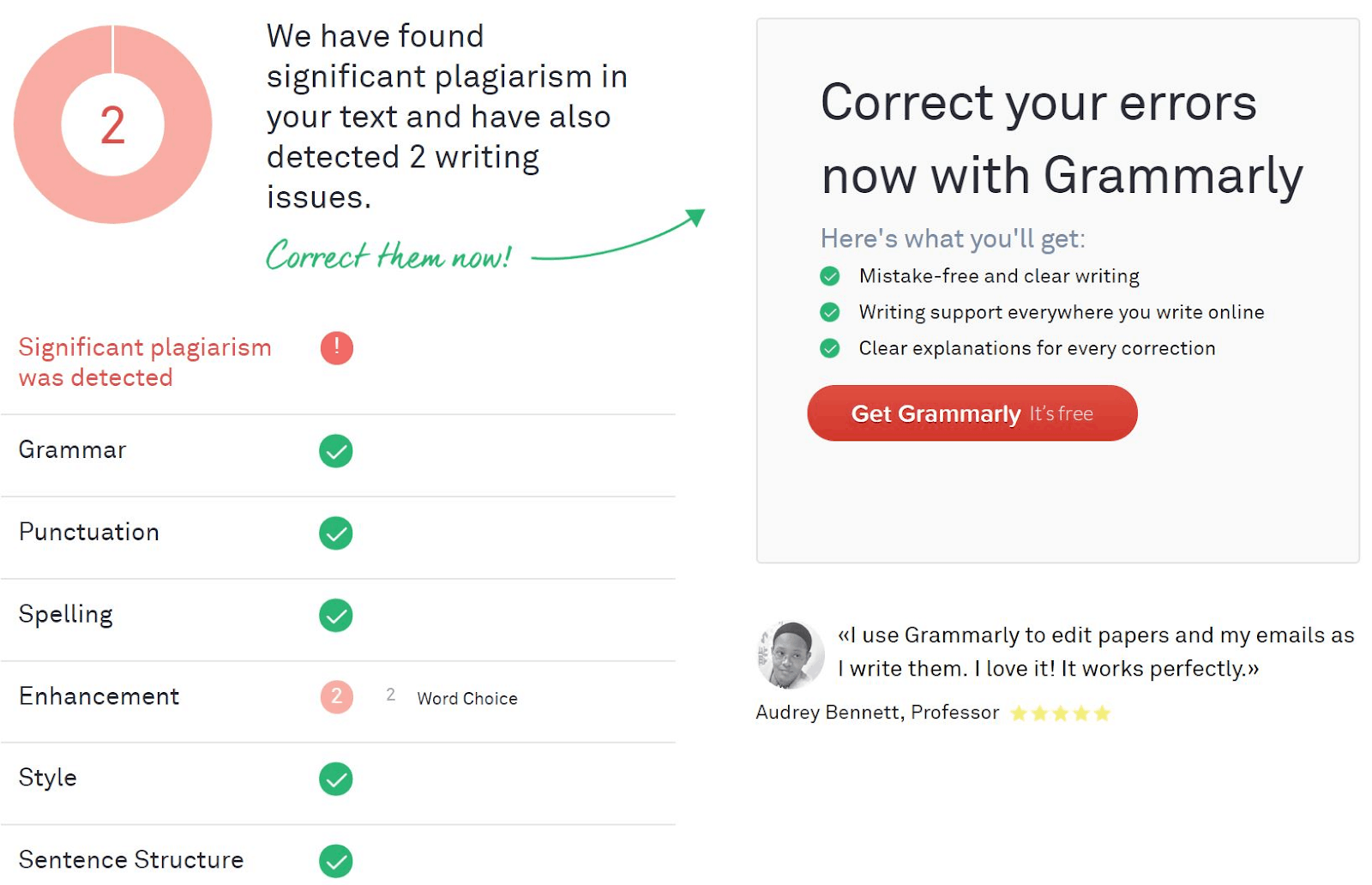Introduction
Paraphrasing is a fundamental skill in writing and communication. It involves expressing the meaning of someone else’s words or ideas in your own words, while maintaining the essence and accuracy of the original content. Paraphrasing is commonly used in academic papers, professional documents, and online content to avoid plagiarism and to present information in a clear and concise manner.
In today’s digital age, the use of online tools has revolutionized the way we write and edit. One such tool is Grammarly, an advanced writing assistant that offers a range of features to help enhance your writing skills. Among these features is the ability to paraphrase your text with ease.
Paraphrasing is not only crucial for academic and professional writing, but it also plays a significant role in improving the overall quality of your content. By paraphrasing effectively, you can present information in a more engaging and concise manner, capturing the attention of your readers and ensuring that your message is effectively communicated.
In this article, we will explore the importance of paraphrasing and how you can utilize Grammarly to paraphrase your text effortlessly. Whether you’re writing an essay, a blog post, or a professional report, mastering the art of paraphrasing is a valuable skill that can elevate the quality of your writing.
So, let’s delve into the world of paraphrasing and discover how Grammarly can be your trusty companion in this journey, guiding you to produce well-crafted and original content.
What is paraphrasing?
Paraphrasing is the process of rephrasing or restating someone else’s words or ideas in your own words. It involves understanding the original information and expressing it using different words and sentence structures, while preserving the original meaning and intent. Paraphrasing is an essential skill in writing as it allows you to incorporate outside sources into your work while maintaining authenticity and credibility.
Paraphrasing goes beyond simple rearranging of words. It requires a deep understanding of the original context and the ability to convey the message in a clear and concise manner. When paraphrasing, it is important to use your own language style and syntax while avoiding plagiarism. By paraphrasing effectively, you demonstrate your comprehension of the topic and showcase your ability to communicate complex ideas in your own voice.
Paraphrasing can be applied to various forms of content, including academic papers, research articles, essays, blog posts, and even social media captions. It allows you to integrate information from multiple sources into your writing, providing supporting evidence and strengthening your arguments. Paraphrasing also enables you to adapt information to your target audience, making it more accessible and easier to understand.
While paraphrasing is commonly used in academic writing to avoid direct quotes and to demonstrate critical thinking, it is equally valuable in other professional contexts. In business, paraphrasing helps convey ideas clearly and succinctly to clients, colleagues, or stakeholders. It assists in summarizing complex concepts, making presentations more engaging, and facilitating effective communication.
Paraphrasing also plays a crucial role in the world of content creation and digital marketing. By paraphrasing information from various sources, you can create original and compelling content that adds value to your readers or target audience. It ensures that your content is unique, searchable, and aligned with the guidelines of search engine optimization (SEO).
In essence, paraphrasing is an essential skill that allows you to incorporate external information into your writing, while preserving the original meaning and showcasing your own voice. It enhances clarity, credibility, and originality in your work, making it a valuable tool in various domains of writing and communication.
Why is paraphrasing important?
Paraphrasing plays a crucial role in effective communication and writing. Here are several reasons why paraphrasing is important:
- Avoiding plagiarism: One of the primary reasons for paraphrasing is to avoid plagiarism. Plagiarism is the act of using someone else’s words or ideas without giving proper credit. By paraphrasing, you can incorporate information from external sources while presenting it in your own words, thereby ensuring that your work is original and giving credit where it is due.
- Demonstrating understanding: Paraphrasing shows your ability to comprehend and interpret information. When you paraphrase effectively, you exhibit a deep understanding of the subject matter by rephrasing it in a way that clearly conveys the intended meaning. It demonstrates critical thinking and mastery of the topic.
- Improving clarity: Paraphrasing helps to make complex ideas more accessible and easier to understand. By rewording dense or technical content, you can simplify it without sacrificing accuracy. This ensures that your readers can grasp the main points more easily and enhances the overall clarity of your writing.
- Enhancing readability: Paraphrasing can improve the readability of your writing by using language and sentence structures that are familiar to your target audience. It allows you to adapt the information to suit the readability level and style of your intended readers, making your content more engaging and relatable.
- Developing your own voice: Paraphrasing is an opportunity to develop your unique writing style and voice. By expressing ideas in your own words, you infuse your personality and perspective into your writing. This helps in building your personal brand and distinguishing yourself as a writer.
- Adding variety: Paraphrasing helps to vary sentence structures and language choices, preventing your writing from becoming monotonous. It allows you to express the same idea in different ways, adding richness and depth to your content. This variety makes your writing more interesting to read and keeps your audience engaged.
- Fulfilling citation requirements: Paraphrasing is often necessary when including information from external sources in your work. By paraphrasing and properly citing your sources, you meet the citation requirements of academic institutions and maintain ethical writing practices.
- Streamlining content: Paraphrasing allows you to condense lengthy passages while retaining the core information. This is particularly useful when you need to summarize or present information concisely. By paraphrasing effectively, you can streamline your content and make it more digestible for your readers.
In summary, paraphrasing is important in avoiding plagiarism, demonstrating understanding, improving clarity, enhancing readability, developing your own voice, adding variety, fulfilling citation requirements, and streamlining content. By mastering the skill of paraphrasing, you can elevate the quality of your writing and effectively convey your ideas to your intended audience.
How to paraphrase manually
Paraphrasing manually involves rewriting someone else’s words or ideas using your own language and sentence structures while maintaining the original meaning. Here are some steps to help you paraphrase effectively:
- Understand the original text: Read and reread the original text thoroughly to ensure that you have a clear understanding of the main ideas and key points. Take notes on the main concepts and supporting details.
- Put the original text aside: After understanding the original text, set it aside and start writing your version from scratch. This will help you avoid the temptation of copying and pasting phrases or sentence structures.
- Express the main idea in your own words: Begin paraphrasing by summarizing the main idea or thesis statement in your own words. Focus on conveying the central message without directly copying the original sentence.
- Use synonyms and different sentence structures: Vary the vocabulary and sentence structures to make your paraphrase distinct from the original text. Replace keywords with synonyms or alternate phrases to maintain the meaning while avoiding plagiarism.
- Change the sentence order: Rearrange the sentence order to provide a different perspective or flow. Break down complex ideas into simpler statements or combine separate ideas to create more concise and coherent sentences.
- Add your own analysis or interpretation: Inject your own insights and analysis into the paraphrased text. This demonstrates your understanding of the topic and allows you to showcase your unique perspective.
- Compare your paraphrase with the original: After writing your paraphrase, compare it with the original text to ensure that you have accurately captured the main ideas and preserved the meaning. Make any necessary adjustments to maintain coherence and clarity.
- Cite the original source: Even though you have paraphrased the text in your own words, it is important to give credit to the original author by citing the source correctly. This maintains academic integrity and avoids plagiarism.
Practicing manual paraphrasing can help you develop your writing skills, avoid plagiarism, and create original content. It allows you to engage more deeply with the source material and express ideas in your own voice.
However, it is important to note that paraphrasing manually can be time-consuming and challenging, especially when dealing with complex or technical content. In such cases, you may consider using online paraphrasing tools like Grammarly to simplify the process and enhance the accuracy of your paraphrases.
Introducing Grammarly
Grammarly is an advanced writing assistant tool that offers a range of features to help improve your writing skills. It is designed to assist writers in producing clear, concise, and error-free content across various platforms, including emails, documents, and online publications.
With millions of users worldwide, Grammarly has become a trusted tool for writers, students, professionals, and anyone looking to enhance their writing proficiency. It provides real-time suggestions and corrections for grammar, spelling, punctuation, style, and clarity, helping you refine your writing and communicate more effectively.
Grammarly comes in two versions: the free version and the premium version. The free version offers basic grammar and spelling checks, while the premium version provides additional features such as advanced language suggestions, plagiarism detection, and vocabulary enhancements.
Grammarly is compatible with various platforms and devices, including web browsers, desktop applications, and mobile devices. It seamlessly integrates into your writing process, offering suggestions and insights as you type, ensuring that your content is error-free and engaging.
One of the standout features of Grammarly is its ability to assist in paraphrasing. With its advanced algorithms and machine learning capabilities, Grammarly provides paraphrasing suggestions to help you rephrase sentences and express ideas in your own words.
By using Grammarly’s paraphrasing feature, you can save time and effort in manually rephrasing your text. It offers alternative phrases and sentence structures, enhancing the clarity and readability of your writing. With a few clicks, you can quickly apply the suggested paraphrases and ensure that your content is original and well-crafted.
Whether you are a student working on an essay, a professional crafting a report, or a content creator developing articles, Grammarly can be a valuable tool to support your writing process. Its user-friendly interface, extensive writing insights, and paraphrasing capabilities make it an indispensable companion for writers of all levels.
Now that we’ve introduced Grammarly, let’s explore how you can utilize its paraphrasing feature to enhance your writing in the next section.
How to paraphrase using Grammarly
Grammarly provides a user-friendly platform for paraphrasing your text effortlessly. Here’s a step-by-step guide on how to utilize Grammarly’s paraphrasing feature:
- Step 1: Writing your text: Start by writing or pasting your text into Grammarly’s editor. You can access Grammarly through its web interface, browser extension, or desktop application.
- Step 2: Enabling Grammarly’s paraphrasing feature: Once your text is loaded, enable the paraphrasing feature by selecting it from the options menu. This signals Grammarly to provide recommendations for rephrasing.
- Step 3: Reviewing paraphrase suggestions: As you write, Grammarly will analyze your text and offer suggestions for paraphrasing specific sentences or phrases. These recommendations will appear as underlined or highlighted text.
- Step 4: Applying paraphrases: Click on the underlined or highlighted text to view Grammarly’s suggested paraphrases. Evaluate the options and choose the one that best suits your intended meaning and style. Click on the suggestion to replace the original text with the paraphrase.
- Step 5: Editing the paraphrased text: After applying the paraphrases, review your text to ensure that the transitions and flow are coherent. Make any necessary edits to integrate the changes seamlessly into your writing.
Grammarly’s paraphrasing feature assists in enhancing the clarity and impact of your writing. It offers alternative word choices, sentence structures, and phrasing suggestions, enabling you to express ideas in a more concise and engaging manner.
When using Grammarly for paraphrasing, remember to maintain the intended meaning of the original text while incorporating your unique style and voice. The goal is to produce original content that accurately represents your ideas.
It is worth noting that while Grammarly’s paraphrasing feature is a valuable tool, it should be used in conjunction with your critical thinking and judgment. Always review the suggested paraphrases and ensure that they effectively convey your intended meaning before applying them.
By leveraging Grammarly’s paraphrasing feature, you can save time and effort in manually rephrasing your text. It enables you to produce well-crafted and original content with ease, whether you’re writing an academic paper, a business report, or a creative piece.
Now that you are familiar with how to paraphrase using Grammarly, let’s explore some additional tips and strategies for effective paraphrasing.
Step 1: Writing your text
The first step in paraphrasing using Grammarly is to write your text. Whether you are creating a new document or working on an existing piece, Grammarly provides a user-friendly platform for writing and editing your content.
You can access Grammarly through its web interface by logging into your account, or you can install the browser extension or desktop application for seamless integration with your preferred writing environment.
Once you have opened Grammarly, you can start writing your text directly in the editor. You can also copy and paste existing content into Grammarly for further editing and paraphrasing.
As you type, Grammarly’s advanced algorithms and machine learning capabilities analyze your text in real-time. It automatically checks for grammar, spelling, punctuation, style, and clarity issues, providing instant suggestions and corrections.
Writing your text in Grammarly offers the advantage of receiving immediate feedback and guidance. You can catch and correct errors as you write, ensuring that your content is error-free and polished.
It is important to note that Grammarly’s paraphrasing feature is available for both the free and premium versions. Whether you are using the free version or have subscribed to Grammarly Premium, you can access the paraphrasing feature to enhance your writing.
When writing your text, remember to focus on expressing your ideas clearly and concisely. Use your own words and provide examples, evidence, or explanations to support your points. Ensure that your writing is coherent, logical, and effectively conveys your intended message.
By writing your text in Grammarly, you can take advantage of its powerful writing assistant capabilities while preparing your content for the paraphrasing process, which we will explore in the next steps.
Now that you have written your text, let’s move on to the next step and enable Grammarly’s paraphrasing feature to begin the paraphrasing process.
Step 2: Enabling Grammarly’s paraphrasing feature
Once you have written your text in Grammarly, the next step is to enable the paraphrasing feature. Enabling this feature will allow Grammarly to provide suggestions for rephrasing specific sentences or phrases in your text.
To enable Grammarly’s paraphrasing feature, you need to access the options menu within the Grammarly editor. The options menu typically appears as a small icon or button somewhere on the interface, commonly located near the top or bottom right corner.
Click on the options menu to expand the available settings and features. Look for the option related to paraphrasing or rephrasing and toggle it on or select it to enable the paraphrasing feature.
Once you have enabled the paraphrasing feature, Grammarly will start analyzing your text and highlighting areas where it suggests alternative phrasing or sentence structures. These suggestions will appear as underlined or highlighted text within your document.
The paraphrasing suggestions provided by Grammarly are tailored to your specific text and context. They are generated based on grammar rules, writing conventions, and sophisticated algorithms, aiming to improve the clarity and effectiveness of your writing.
Enabling Grammarly’s paraphrasing feature gives you access to a vast range of alternative phrasing options that can help you refine your writing, create clearer sentences, and convey your ideas more effectively.
By providing you with these paraphrasing suggestions, Grammarly empowers you to improve the flow and readability of your writing while maintaining your unique voice and style.
Now that you have enabled Grammarly’s paraphrasing feature, it’s time to explore the next step: reviewing the paraphrase suggestions provided by Grammarly.
Step 3: Reviewing paraphrase suggestions
Once you have enabled Grammarly’s paraphrasing feature, the next step is to review the paraphrase suggestions it provides. As you continue writing or editing your text in Grammarly, the tool will analyze your writing and highlight areas where it suggests alternative phrasing or sentence structures.
These paraphrase suggestions appear as underlined or highlighted text within your document, indicating specific areas where improvements can be made. By clicking on the underlined or highlighted text, you can access Grammarly’s proposed paraphrases.
When reviewing the paraphrase suggestions, take the time to carefully evaluate each option. Consider the clarity, coherence, and flow of the suggested paraphrases. Ask yourself if the alternative phrasing effectively conveys your intended meaning and aligns with the overall tone and style of your writing.
Grammarly’s paraphrase suggestions are generated using advanced algorithms and language models. They are based on grammar rules, writing conventions, and a vast database of textual examples. However, it’s essential to remember that the tool is an assistance tool and that the final decision is yours as the writer.
During this step, take into account your original intent and writing style. Consider how each suggested paraphrase enhances or alters the meaning of the original text. Choose the paraphrase that best aligns with your desired message and effectively communicates the information to your intended audience.
While evaluating the paraphrase suggestions, you may find that some are more suitable than others, or you may decide to make slight modifications to the suggested paraphrases to better fit your writing style. The goal is to create well-crafted and original content while maintaining clarity and effectiveness.
Reviewing the paraphrase suggestions provided by Grammarly allows you to leverage the tool’s expertise and the range of alternative phrasing options available. It enhances the overall quality of your writing and ensures that your content is engaging and well-expressed.
Once you have reviewed the paraphrase suggestions, it’s time to move on to the next step and apply the selected paraphrases to your text.
Step 4: Applying paraphrases
After reviewing the paraphrase suggestions provided by Grammarly, the next step is to apply the selected paraphrases to your text. Applying these paraphrases will help you refine your writing and ensure that your content is original and well-crafted.
To apply the paraphrases suggested by Grammarly, simply click on the underlined or highlighted text where the suggested paraphrase appears. This will open a dropdown menu displaying the alternative phrasing options.
Take the time to evaluate each suggested paraphrase option, considering how it aligns with your intended meaning, style, and tone. Choose the paraphrase that best suits your unique voice and effectively conveys your ideas.
Once you have selected the preferred paraphrase from the dropdown menu, click on it to replace the original text with the chosen alternative. Grammarly will automatically update your document, reflecting the applied paraphrase.
It’s important to note that while Grammarly’s paraphrasing suggestions are helpful, it’s crucial to consider the context and ensure that the chosen paraphrase accurately represents your intended message. You may choose to make slight modifications to the paraphrase if needed to maintain clarity and coherence within your writing.
By applying the paraphrase suggestions, you integrate the alternative phrasing options provided by Grammarly into your text. This helps you create content that is uniquely yours while benefiting from the tool’s expertise in enhancing clarity and effectiveness.
Remember, as the writer, you have the final say in applying paraphrases. Grammarly serves as a tool to aid and enhance your writing process, but it’s your judgment and understanding of the content that determine the final choice of paraphrases.
Now that you have applied the paraphrases to your text, proceed to the next step and review and edit the paraphrased text to ensure its coherence and flow.
Step 5: Editing the paraphrased text
After applying the paraphrases suggested by Grammarly, the final step is to review and edit the paraphrased text to ensure its coherence and flow. Editing allows you to fine-tune your writing and ensure that the paraphrases seamlessly integrate into your overall piece.
Start by reading through the paraphrased text and consider how each paraphrase fits within the context of your writing. Assess whether the overall message and meaning remain consistent and whether the new phrasing enhances clarity and effectiveness.
During the editing process, pay attention to the transition between sentences and paragraphs. Ensure that the paraphrased text maintains a logical flow and progression, allowing your readers to follow your intended argument or narrative.
Consider the coherence of the paraphrased text with the surrounding sentences and paragraphs. Make any necessary adjustments to ensure that the paraphrased text blends seamlessly with the rest of your writing.
Take the opportunity to refine your writing style and tone in the paraphrased sections. Consider whether the new phrasing aligns with the desired voice and style of your piece. Make adjustments as needed to maintain consistency throughout your writing.
Additionally, review the grammar, punctuation, and spelling in the paraphrased text. While Grammarly provides suggestions for paraphrasing, it’s crucial to ensure that the final text is free from any grammatical errors or typos.
As you edit the paraphrased text, ask yourself if the overall meaning and intention of your original content have been preserved. Consider if the changes have improved clarity and conciseness, and if the new phrasing effectively communicates your ideas.
Remember, the editing process is an opportunity for you to refine and polish your writing. Take the time to read through your paraphrased text multiple times to ensure its coherence and effectiveness.
By carefully reviewing and editing the paraphrased text, you can ensure that it seamlessly integrates into your writing, enhancing its overall quality and impact.
Now that you have gone through the steps of paraphrasing using Grammarly and editing the paraphrased text, you are well-equipped to produce original and well-crafted content. However, it’s important to continue practicing and refining your paraphrasing skills to further enhance your writing proficiency.
Conclusion
Paraphrasing is a valuable skill that is essential for effective communication and writing. Whether you are a student, a professional, or a content creator, mastering the art of paraphrasing can elevate the quality of your work and help you communicate your ideas with clarity and impact.
In this article, we discussed the importance of paraphrasing and how it allows you to incorporate external information while maintaining authenticity and avoiding plagiarism. We explored the manual paraphrasing process, which involves understanding the original text, expressing ideas in your own words, and applying various techniques to convey the same meaning.
We also introduced Grammarly, an advanced writing assistant tool that offers a range of features to enhance your writing skills. Grammarly’s paraphrasing feature provides invaluable support by suggesting alternative phrasing options and helping you refine your writing effortlessly.
By following the step-by-step process of writing your text, enabling Grammarly’s paraphrasing feature, reviewing the paraphrase suggestions, applying the chosen paraphrases, and editing the paraphrased text, you can create content that is both original and well-crafted.
Remember, paraphrasing is a skill that requires practice and refinement. While Grammarly’s paraphrasing feature can assist you in the process, it’s essential to exercise your critical thinking and judgment to ensure that the final output is coherent, effective, and aligned with your intended message.
By harnessing the power of paraphrasing and utilizing tools like Grammarly, you can enhance the quality and clarity of your writing, captivate your audience, and effectively convey your ideas. So, practice, experiment, and embrace the art of paraphrasing to become a skilled and persuasive communicator.
Now, armed with these insights and techniques, go forth and unleash the power of paraphrasing to take your writing to new heights!

























